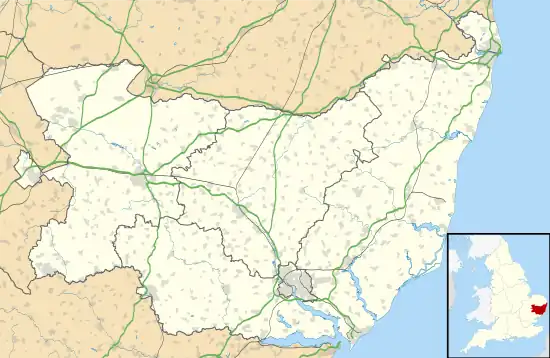Lavenham Guildhall
Lavenham Guildhall is a timber-framed municipal building in Lavenham, Suffolk, England. It is Grade I listed.[1]
| Lavenham Guildhall | |
|---|---|
 | |
| Location | Lavenham, Suffolk |
| Coordinates | 52.1088°N 0.7966°E |
| Built | 1529 |
| Architectural style(s) | Jettied timber framing |
Listed Building – Grade I | |
| Designated | 23 January 1958 |
| Reference no. | 1037186 |
 Location of Lavenham Guildhall in Suffolk | |
History
By the late 14th century, Lavenham was at the centre of the East Anglian woollen cloth trade.[2] Its specialised production of woad-dyed broadcloth, known as Lavenham Blue,[3] had made it one of the richest towns in England.[lower-alpha 1] This wealth was the catalyst for four guilds being established in the town by the local merchant families: the most important of these was the Guild of Corpus Christi formed in 1529.[9] The guild established their guildhall at around that time; the design made extensive use of jettied timber framing and featured a gabled porch projecting from the centre of the building on the north-west elevation.[1]
With the decline of the woollen cloth trade and Lavenham's prosperity, the guildhall's role changed. By 1689, the guildhall was in use as a bridewell, and from 1787 it was used as a workhouse.[1] Prison cells and mortuary buildings were established in the area behind the guildhall in 1833.[7] In 1887, the guildhall was acquired by Sir Cuthbert Quilter, a local member of parliament. He soon started restoring the building, but this was only completed in around 1911.[1]
The building was used as a social club for American troops stationed nearby[10] and also as a British Restaurant during the Second World War and, in 1946, Sir William Quilter gave it to the people of Lavenham.[2] It became the property of the National Trust in 1951 and it was subsequently opened to the public as a local history museum.[11][12]
Inside the guildhall, in addition to exhibits presenting the evolution of the guildhall from cloth trade to workhouse, there is a display of memorabilia associated with Lavenham railway station, which was a stop on the Long Melford–Bury St Edmunds branch line before it closed in 1961.[7]
Notes
References
- Historic England. "The Guildhall (Grade I) (1037186)". National Heritage List for England. Retrieved 12 July 2014.
- "History of Lavenham Guildhall". The National Trust. Retrieved 26 January 2020.
- "Hundreds of visitors expected at Colours to Dye For weekend in west Suffolk". Sudbury Mercury. 14 July 2018. Retrieved 21 August 2020.
- Betterton, Alex (1 January 1995). "The Guildhall, Lavenham". History Today. Retrieved 21 August 2020.
- Hoskins, William George (2015). Local History in England. Routledge. ISBN 978-1138835924.
- "The tiny Suffolk village that was once among the richest places in England". The Telegraph. 26 June 2020. Retrieved 21 August 2020.
- "Lavenham Guildhall - An exceptional medieval building in Suffolk". Archaeology Travel. Retrieved 21 August 2020.
- Walker, Greg (1988). John Skelton and the Politics of the 1520s. Cambridge: Cambridge University Press. p. 112. ISBN 9780521521390.
- Pevsner, Nikolaus (March 1974). The Buildings of England: Suffolk. Yale University Press. ISBN 978-0300096484.
- "A very crooked tea: the Crooked House, Lavenham". American Hour. 5 October 2016. Retrieved 21 August 2020.
- "Lavenham Guildhall". The National Trust. Retrieved 21 August 2020.
- "Have you visited these top 25 historic places in Norfolk and Suffolk?". Ipswich Star. 8 July 2017. Retrieved 21 August 2020.
External links
- Lavenham Guildhall - National Trust